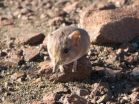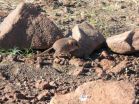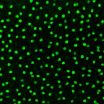(Press-News.org) SAN FRANCISCO (June 26, 2014) – Scientists from the California Academy of Sciences have discovered a new species of round-eared sengi, or elephant-shrew, in the remote deserts of southwestern Africa. This is the third new species of sengi to be discovered in the wild in the past decade. It is also the smallest known member of the 19 sengis in the order Macroscelidea. The team's discovery and description of the Etendeka round-eared sengi (Macroscelides micus) is published this week in the Journal of Mammalogy.
While collecting and examining sengi specimens from southwestern Africa, Drs. Jack Dumbacher and Galen Rathbun encountered an unusual specimen collected in the remote northwestern region of Namibia that differed in appearance from any of the museum specimens that they had examined previously. The specimen was significantly smaller, had rust-colored fur, a large, hairless gland on the underside of its tail, and lacked dark skin pigment. Preliminary genetic analysis also showed important differences between this specimen and close relatives.
Suspecting they may have encountered a new species, the team—including research colleagues in Namibia, Timothy Osborne (California Academy of Sciences), Michael Griffin (Republic of Namibia Ministry of Environment and Tourism), and Seth Eiseb (National Museum of Namibia), all co-authors on the paper—set out on nine expeditions between 2005-2011. In total, the team collected 16 specimens for comparative analyses.
Comparing the specimens to those in natural history collections in Windhoek, Pretoria, London, Los Angeles, and the Academy in San Francisco, and further genetic analysis, confirmed that they had, in fact, found a new species, demonstrating the critical role that scientific collections play in biodiversity studies.
"Had our colleagues not collected those first invaluable specimens, we would never have realized that this was in fact a new species, since the differences between this and all other known species are very subtle," says Dumbacher, the Academy's Curator of Ornithology and Mammalogy. "Several museum collections were instrumental in determining that what we had was truly new to science, highlighting the value of collections for this type of work. Genetically, Macroscelides micus is very different from other members of the genus and it's exciting to think that there are still areas of the world where even the mammal fauna is unknown and waiting to be explored."
Sengis are restricted to Africa and, despite their small size, are more closely related to elephants, sea cows, and aardvarks than they are to true shrews. Found in a remote area of Namibia, on the inland edge of the Namib Desert at the base of the Etendeka Plateau, scientists believe this new species went undescribed for so long because of the challenges of doing scientific research in such an isolated area. Yet it is precisely this isolation, and the unique environmental conditions in the region, that have given rise to this and other endemic organisms.
An Etendeka round-eared sengi specimen has been added to the Namib Desert diorama exhibit in the Academy's African Hall, part of its natural history museum. It joins a replica of Welwitschia mirabilis, an ancient plant also endemic to the Namib Desert that may live for up to 2,500 years. The plant's wide, drooping leaves provide important habitat for other endemic species, such as the black-and-yellow spotted firebug (Probergrothius sexpunctatus).
"With only about a dozen new species of mammal discovered in the wild each year, it is amazing that the Academy has been involved in describing three new sengis in the last decade," says Rathbun, an authority on the biology of sengis and an Academy Fellow and Research Associate. "There are new and exciting insights into biodiversity awaiting discovery, even in a group as familiar as mammals."
INFORMATION:
About Research at the California Academy of Sciences
The Institute for Biodiversity Science and Sustainability at the California Academy of Sciences is at the forefront of efforts to understand two of the most important topics of our time: the nature and future of life on Earth. Based in San Francisco, the institute is home to more than 60 research scientists and aquarium biologists, as well as 45.6 million scientific specimens from around the world—nearly 40,000 of which are alive and on display in the Academy's Steinhart Aquarium. The institute also leverages the expertise and efforts of more than 100 international Research and Field Associates and 300 distinguished Fellows. Through expeditions around the globe, captive breeding programs, and investigations in the lab, the institute's scientists strive to understand the evolution and interconnectedness of life. Through these same efforts, as well as through partnerships, community outreach, and public engagement initiatives, the institute aims to guide critical conservation decisions and address the challenge of sustainability.
Dr. Galen Rathbun is one of the world's foremost experts on sengis. For more information about sengis and their biology, visit http://www.sengis.org.
New species of small mammal discovered by scientists from California Academy of Sciences
Round-eared elephant-shrew found in Namibia represents newest addition to the order Macroscelidea
2014-06-26
ELSE PRESS RELEASES FROM THIS DATE:
Miriam Hospital researchers develop app focused on making obese adults less sedentary
2014-06-26
PROVIDENCE, R.I. – Even individuals who exercise a lot can be at risk for health problems if they also spend a lot of time in sedentary behaviors, such as sitting. More sedentary time, regardless of physical activity levels, is associated with greater risk for obesity, cardiovascular disease and mortality. However, a smartphone-based intervention developed by researchers at The Miriam Hospital can produce short-term reductions in sedentary behavior that may be effective in improving health. The findings of a study that utilized this app are published in PLOS ONE, a peer-reviewed ...
You can't teach speed: Sprinters break 10-year rule
2014-06-26
ALLENDALE, Mich. — New research shows world-class sprinters are born, not created. Grand Valley State University researchers found that exceptional speed prior to formal training is a prerequisite for becoming a world-class sprinter. The findings are published in the online journal PeerJ, https://peerj.com/articles/445/.
The research, conducted by Michael Lombardo, professor of biology, and Robert Deaner, associate professor of psychology, shows that the developmental histories of elite sprinters contradict the popular deliberate practice model of expertise. According ...
The social psychology of nerve cells
2014-06-26
The functional organization of the central nervous system depends upon a precise architecture and connectivity of distinct types of neurons. Multiple cell types are present within any brain structure, but the rules governing their positioning, and the molecular mechanisms mediating those rules, have been relatively unexplored.
A new study by UC Santa Barbara researchers demonstrates that a particular neuron, the cholinergic amacrine cell, creates a "personal space" in much the same way that people distance themselves from one another in an elevator. In addition, the study, ...
US should re-evaluate definition of skilled workers in immigration policy
2014-06-26
New immigration research from Rice University, the University of North Carolina and the Centre for Population, Poverty and Public Policy Studies suggests the U.S. should re-evaluate its definition of skilled workers to include informal skills of migrant workers.
The study, "Identifying and Measuring the Lifelong Human Capital of 'Unskilled' Migrants in the Mexico-U.S. Migrator Circuit," draws on a binational multistage research project that involved interviews with 320 Mexican migrants and return migrants in North Carolina and Guanajuato, Mexico. The study identifies ...
Researchers home in on way to predict aggressiveness of oral cancer
2014-06-26
Studying mouth cancer in mice, researchers have found a way to predict the aggressiveness of similar tumors in people, an early step toward a diagnostic test that could guide treatment, according to researchers at Washington University School of Medicine in St. Louis.
"All patients with advanced head and neck cancer get similar treatments," said Ravindra Uppaluri, MD, PhD, associate professor of otolaryngology. "We have patients who do well on standard combinations of surgery, radiation and chemotherapy, and patients who don't do so well. We're interested in finding out ...
Over-activity of enzyme HDAC6 exacerbates symptoms of Amyotrophic Lateral Sclerosis
2014-06-26
Scientists at VIB and KU Leuven have demonstrated in fruit-flies that over-activity of the enzyme HDAC6 in the nerve ends exacerbates the symptoms of the neurodegenerative condition Amyotrophic Lateral Sclerosis (ALS / Lou Gehrig's Disease). Inhibition of this enzyme could offer a protective effect against ALS.
Patrik Verstreken (VIB/KU Leuven): "Nobody wants to suffer from a degenerative condition such as amyotrophic lateral sclerosis (ALS), in which you lose coordination of all muscles through gradual damage to the nerve cells. ALS patients are conscious throughout ...
Organic agriculture boosts biodiversity on farmlands
2014-06-26
Organic farming fosters biodiversity. At least that's the theory. In practice, however, the number of habitats on the land plays an important role alongside the type and intensity of farming practices. These are the findings of an international study that looked at 10 regions in Europe and two in Africa. The results has been published in Nature Communications. The study shows that even organic farms have to actively support biodiversity by, for example, conserving different habitats on their holdings.
An international team, including participants from Technische Universität ...
We speak as we feel -- we feel as we speak
2014-06-26
A team of researchers headed by the Erfurt-based psychologist Prof. Ralf Rummer and the Cologne-based phoneticist Prof. Martine Grice has carried out some ground-breaking experiments to uncover the links between language and emotions. They were able to demonstrate that the articulation of vowels systematically influences our feelings and vice versa.
The research project looked at the question of whether and to what extent the meaning of words is linked to their sound. The specific focus of the project was on two special cases; the sound of the long 'i' vowel (/i:/) and ...
Rosin up that bow, maestro. And thank your genes
2014-06-26
EAST LANSING, Mich. --- Mom or dad may have driven you to cello rehearsal all those years, but you can also thank your genes for pushing you to practice, according to new research led by a Michigan State University professor.
Genetics and environment work together to help people become accomplished musicians, finds the study of 850 sets of twins. It's another arrow in the quiver of the argument that both nature and nurture play a role in developing expertise.
"The nature vs. nurture debate has raged since the beginning of psychology," said Zach Hambrick, MSU professor ...
Packing hundreds of sensors into a single optical fiber for use in harsh environments
2014-06-26
WASHINGTON, June 26, 2014—By fusing together the concepts of active fiber sensors and high-temperature fiber sensors, a team of researchers at the University of Pittsburgh has created an all-optical high-temperature sensor for gas flow measurements that operates at record-setting temperatures above 800 degrees Celsius.
This technology is expected to find industrial sensing applications in harsh environments ranging from deep geothermal drill cores to the interiors of nuclear reactors to the cold vacuum of space missions, and it may eventually be extended to many others.
The ...
LAST 30 PRESS RELEASES:
Fertility remains high in rural Tanzania despite access to family planning
AI-assisted device can improve autism care access
Kinetic careers
Uncovering how parasitic plants avoid attacking themselves to improve crop resistance
Nanoparticle vaccine strategy could protect against Ebola and other deadly filoviruses
Study finds brain care score can predict risk of stroke across racial groups
Key lung immune cells can intensify allergic reactions
Do hormones explain why women experience more gut pain?
New materials conduct ions in solids as easily as in liquids
Breakthrough of the Year: Renewable energy begins to eclipse fossil fuel-based sources
LLM use is reshaping scientific enterprise by increasing output, reducing quality and more
Introducing LightGen, a chip for ultra-fast, ultra-efficient generative AI
Astronomers see fireworks from violent collisions around nearby star
ACC/AHA issue new guideline on managing congenital heart disease in adults
Cosmic crash caught on camera
Is talented youth nurtured the wrong way? New study shows: top performers develop differently than assumed
Ants: An untapped resource in the development of antibiotics?
Archaeologists use AI to create prehistoric video game
Mitochondria migrate toward the cell membrane in response to high glucose levels
Tiny viral switch offers hope against drug-resistant bacteria
Most parents aware of early peanut introduction guidelines, but confused about details
HPV vaccine can protect against severe lesions of the vulva and vagina
Virtual care provision and emergency department use among children and youth
Quadrivalent HPV vaccine and high-grade vulvovaginal lesions
Insights into dry eyes gained from stem cell-derived tear glands
Researchers identify 166 human pluripotent stem cell lines available for use in clinical applications
Europa Clipper instrument uniquely observed interstellar comet 3I/ATLAS
UN University Report challenges climate change as sole trigger of Syrian Civil War, exposing governance failures in drought response
Real estate investment trust (REIT) acquisition associated with hospital closure and bankruptcy
New Raman imaging system detects subtle tumor signals
[Press-News.org] New species of small mammal discovered by scientists from California Academy of SciencesRound-eared elephant-shrew found in Namibia represents newest addition to the order Macroscelidea







